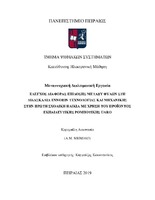Έλεγχος διαφοράς επίδοσης μεταξύ φύλων στη διδασκαλία εννοιών τεχνολογίας και μηχανικής στην πρώτη σχολική ηλικία με χρήση του προϊόντος εκπαιδευτικής ρομποτικής UARO
Controlling the difference in performance amongst the sexes in teaching technology concepts and mechanics in the first school age using the robotics educational product UARO

View/
Keywords
STEM ; UARO ; Εκπαιδευτική ρομποτική ; Πρώτη σχολική ηλικία ; Φύλο ; Φυλετικό τεχνολογικό χάσμαAbstract
The skills that today's students need to acquire include the cultivation of skills and behaviors directly related to new technologies and their interaction with them. Problem-solving, critical thinking, collaboration and creativity are some of the skills that are recognized as necessary for 21st-century students. In the development of such skills, sciences such as mathematics, physics, computer science and technology (STEM) can make a significant contribution to the tools and activities they offer.
At the same time, the need to strengthen the interest of young people in the STEM scientific fields and the corresponding professions has been stressed. As a result of this, in recent years there has been a shift towards the STEM sectors in the global educational community. Robotics is considered by many researchers as one of the most appropriate means for students to engage with the STEM sciences because of its interdisciplinary nature. Considering that technology plays a vital role in jobs and that most of the new professions either in private or in the public sector will be technologically oriented, an important question arises as to whether the two sexes have equal opportunities and equal participation in this rapid growing orientation. This research examines the performance of boys and girls in educational robotics activities. It controls whether one of the sexes is superior to the skills and abilities associated with this subject as well as factors that can contribute to this difference in performance. In the course of its work, specially designed worksheets for the UARO educational robotics product were used as well as questionnaires given to students after the meetings. The results showed that both sexes responded equally well and with the same enthusiasm to the robotics activities and understood through them concepts of physics, mechanics and mathematics. However, they differ in the use of their leisure time and in their professional orientation. The results highlight the need for further examination of the social institutions and factors that influence the formation of gender orientations.


